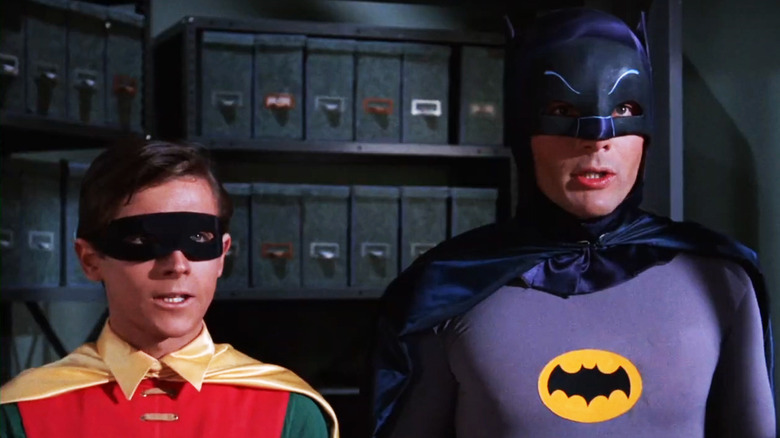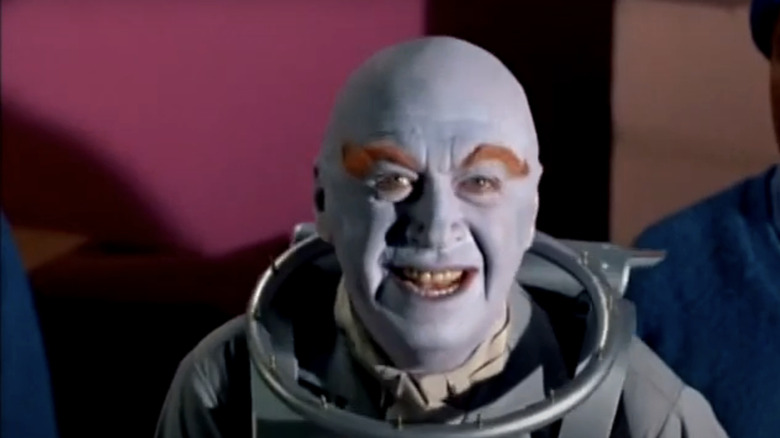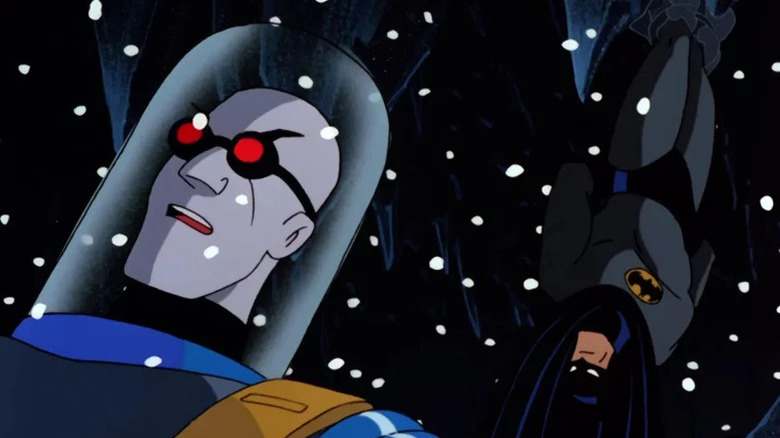How The '60s Batman TV Series Led To A Supervillain Changing His Name In The Comics
1950s and '60s "Batman" comic books produced some of the most amusingly ridiculous storylines in the Dark Knight's history. At a time when science fiction was all the rage, the comics had transformed Bob Kane and Bill Finger's "weird figure of the dark" from 1939's "Detective Comics" #27 into a campy boy scout whose adventures involved fantastical villains, aliens, and space travel.
This was the era that gave us some of the most memorably absurd "Batman" covers yet, such as 1958's "Batman" #118, which featured a version of the Caped Crusader who while trapped in a water tank exclaimed, "Yes Robin, I've become a human fish!" Then, there was 1966's "Detective Comics" #356, which came adorned with a Boy Wonder shocked by the fact he was "turning into a coffin!" 1960's "Detective Comics" #282 saw Batman battle an "interplanetary rival" in the form of a "Krajan Cave-Eel" and 1959's "Batman" #121 featured "the ice crimes of Mr. Zero," who tried to turn the dynamic duo into "the most valuable live trophies in the world" by encasing them in blocks of ice.
It's perhaps not all that surprising that few of these fantastical storylines served as the genesis for long lasting elements of the Batman mythos. But that doesn't hold for Mr. Zero, who actually went on to become one of the most recognizable rogues in the Dark Knight's famous gallery — despite Arnold Schwarzenegger's regrettable depiction in a notoriously bad '90s Batman movie. But in order for that to happen, the character needed a little help from the 1960s "Batman" TV show.
The Batman TV show gave us Mr. Freeze as we know him
Depending on your sensibilities, the 1960s "Batman" TV show is either pure joy or an affront to Batman which turned the character into little more than a disposable, kitschy joke in the public consciousness. At least, that might be how certain Bat-fans felt before Tim Burton came along in 1989 and restored Batman's standing as a brooding avenger of the night. Viewed in context now, the "Batman" TV series was clearly a crucial step in the evolution of the character, not only keeping him relevant but taking him from a successful comic book character to a pop culture icon.
The show also had a more subtle influence on Batman lore itself. Take Mr. Zero, for instance. The villain who had debuted in 1959's "Batman" #121 had been largely forgotten by the time the TV series decided to dust him off and give him a name change. First appearing in season 1 episode "Instant Freeze," Mr. Freeze was portrayed by George Sanders, and was depicted as a scientist named Doctor Schievel who had been transformed into the now-legendary villain after being drenched by a beaker of "Instant Freeze" during a fight with Batman. He then turned up again in season 1 in the episode "Rats Like Cheese," again portrayed by Sanders, before returning for four more episodes in season 2. For his second season appearances, the character was played by Otto Preminger for two episodes and Eli Wallach for another two.
Mr. Freeze wouldn't return before "Batman" was canceled after three seasons, but his legacy lives on in the form of his comic book counterpart, who, following the popularity of the TV show, was also renamed to Mr. Freeze.
Mr. Freeze makes his comic book debut (again)
"Batman" went off the air in 1968, but that same year saw Mr. Zero make a return to the comic books following his 1959 debut. This time, the character had also changed his name to Mr. Freeze, matching that of the TV series villain. 1968's "Detective Comics" #373 saw the character re-emerge to menace Gotham City in a story titled "Mr. Freeze's Chilling Deathtrap." Written by Gardner Fox and illustrated by Chic Stone, the story even includes a sly nod to Mr. Freeze's new moniker and its small-screen origins when Batman refers to him as "Mr. Zero" before correcting himself. Robin then says, "Mr. Freeze! That sounds like a campy name dreamed up for a villain in a television program."
Without the "Batman" series, Mr. Freeze almost certainly wouldn't have become the legendary Batman rogue he is today — though it should be said that his longevity is also attributable to "Batman: The Animated Series." Though it was an altogether darker affair, that beloved '90s show very much followed in the footsteps the 1960s "Batman" series by reinventing Mr. Freeze for a new generation. "Heart of Ice" remains one of the best episodes of "Batman: The Animated Series" for reimagining Mr. Freeze as Victor Fries, a much more tragic version of the character who was on a mission to find a cure for his wife Nora's terminal illness. This backstory was then adopted by the comics, and has become the default origin for Mr. Freeze ever since.
Considering the character's origin as a gimmicky villain of the week who emerged during a questionable period in "Batman" comics, this is a remarkable trajectory that demonstrates the importance of Batman lore being reimagined in various media as a way of prolonging and improving on the characters' rich history. "Batman Forever" actor Val Kilmer was right when he talked about the character being a blank slate, in the sense that his story and lore allows for endless reinterpretation, which in and of itself is a big part of why the character and his rogues gallery have remained popular for almost a century.


